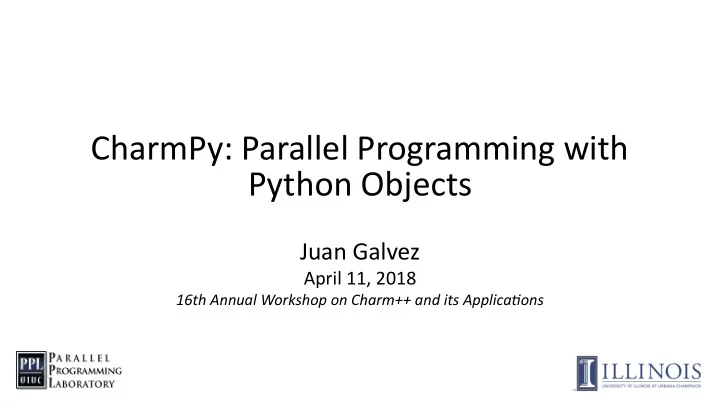

CharmPy: Parallel Programming with Python Objects Juan Galvez April 11, 2018 16th Annual Workshop on Charm++ and its Applicatons
What is CharmPy? ● Parallel/distributed programming framework for Python ● Charm++ programming model (Charm++ for Python) ● High-level, general purpose ● Runs on top of Charm++ runtme (C++) ● Good runtme performance ● Adaptve runtme features: asynchronous remote method invocaton, dynamic load balancing, automatc communicaton/computaton overlap
Why CharmPy? ● Python+Charmpy easy to learn/use, many productvity benefts ● Bring Charm++ to Python community – No high-level & fast & highly-scalable parallel frameworks for Python ● Beneft from Python sofware stack – Python widely used for data analytcs, machine learning – Opportunity to bring data and HPC closer ● Cons? – Potentally, performance, BUT performance can be similar to C++
Charmpy Python-derived benefts ● Productvity (high-level, less lines of code, easy to debug) ● Automatc memory management ● Automatc object serializaton – No need to defne serializaton (PUP) routnes – Can customize serializaton if needed ● Easy access to Python sofware libraries (numpy, pandas, scikit-learn, TensorFlow, etc)
Charmpy-specifc features ● Simplifes Charm++ programming – Much simpler, more intuitve API ● No specialized languages, preprocessing or compilaton – Using refecton/introspecton – Everything can be expressed in Python – No interface (ci) fies!
Hello World #hello_world.py from charmpy import charm, Chare, Group class Hello (Chare): def sayHi(self, vals): print('Hello from PE', charm.myPe(), 'vals=', vals) self.contribute(None, None, self.thisProxy[0].done) def done(self): charm.exit() def main(args): g = Group(Hello) # create a Group of Hello chares g.sayHi([1, 2.33, 'hi']) charm.start(entry=main)
Run Hello World $ ./charmrun +p4 /usr/bin/python3 hello_world.py # similarly on a supercomputer with aprun/srun/… Hello from PE 0 vals= [1, 2.33, 'hi'] Hello from PE 3 vals= [1, 2.33, 'hi'] Hello from PE 1 vals= [1, 2.33, 'hi'] Hello from PE 2 vals= [1, 2.33, 'hi']
Charmpy components Other Python libraries/technologies: numpy, numba, pandas, matplotlib, scikit-learn, TensorFlow, ... Python application import charmpy C / C++ / Fortran / OpenMP charmpy module cython charmlib interface layer cython ctypes cffi Charm++ shared library (libcharm.so)
What about performance? ● Many (compiled) parallel programming languages proposed over the years for HPC ● Use Python in same way: high-level language driving machine-optmized compiled code – Numpy (high-level arrays/matrices API, natve implementaton) – Numba (JIT compiles Python “math/array” code) – Cython (compile generic Python to C)
Numba ● Compiles Python to natve machine using LLVM compiler – Good for loops and numpy array code @numba.jit (from http://numba.pydata.org) def sum2d(arr): M, N = arr.shape result = 0.0 for i in range(M): for j in range(N): result += arr[i,j] return result a = arange(9).reshape(3,3) print(sum2d(a))
Numba ● Interestng feature: – Input parameters that are normally variables can be compiled as constants thanks to JIT compilaton Values can be supplied at @numba.jit launch, but be def compute(arr, ...) compiled as for x in range (block_size_x): constants for y in range (block_size_y): arr[x,y] = ... ● Can write CUDA kernels
Chares are distributed Python objects ● Remote methods invoked like regular Python objects, via proxy: obj_proxy.doWork(x, y) ● Objects are migratable (handled by Charm++ runtme) ● Method invocaton asynchronous in general (good for performance) ● Can also do: ret = obj_proxy.getVal(block=True) – Caller gets value returned by remote method – Entry method on which call is made needs to be marked as @threaded (runtme will inform)
Distributed collectons (Groups, Arrays) group = Group (MyChare) # one instance per PE array = Array (MyChare, (100,100)) # 2D array, 100x100 # instances array.work(x,y,z) # invoke method on all objects in # array array[3,10].work(x,y,z) # invoke method on object with # index (3,10)
Reductons ● Reducton (e.g. sum) by elements in a collecton: def work(self, x, y, z): A = numpy.arange(100) self.contribute(A, Reducer.sum, obj.collectResults) ● Easy to defne custom reducer functons. Example: – def mysum(contributions): return sum(contributions) – self.contribute(A, Reducer.mysum, obj.collectResult)
Benchmark using stencil3d ● In examples/stencil3d, ported from Charm++ ● Stencil code, 3D array decomposed into chares ● Full Python applicaton, array/math sectons JIT compiled with Numba ● Cori KNL 2 nodes, strong scaling from 8 to 128 cores
stencil3d results on Cori KNL
Evoluton of performance
Benchmark using LeanMD ● MD mini-app for Charm++ ( htp://charmplusplus.org/miniApps/#mleanmd) – Simulates the behavior of atoms based on the Lennard-Jones potental – Computaton mimics the short-range non-bonded force calculaton in NAMD – 3D space consistng of atoms decomposed into cells – In each iteraton, force calculatons done for all pairs of atoms within the cutof distance ● Ported to Charmpy, full Python applicaton. Physics code and other numerical code JIT compiled with Numba
LeanMD results on Blue Waters Avg difference is 19% (results not based on latest Charmpy version)
Serializaton (aka pickling) ● Most Python types, including custom types, can be pickled ● Can customize pickling with __getstate__ and __setstate__ methods ● pickle module implemented in C, recent versions are prety fast (for built-in types) – Pickling custom objects not recommended in critcal path ● Charmpy bypasses pickling for certain types like numpy arrays
Shared memory parallelism ● In the Python interpreter, NO – CPython (most common Python implementaton) stll can’t run multple threads concurrently ● Outside the interpreter, YES – Numpy internally runs compiled code, can use multple threads (Intel Python + numpy seems to be very good at this) – Access external OpenMP code from Python – Numba parallel loops
Summary ● Easy way to write parallel programs based on Charm++ model ● Good runtme performance – Critcal sectons of Charmpy runtme in C with Cython – Most of the runtme is C++ ● High performance using NumPy, Numba, Cython, interactng with natve code ● Easy access to Python libraries, like SciPy and PyData stacks
Thank you! ● More resources: ● Documentaton and tutorial at htp://charmpy.readthedocs.io ● Examples in project repo: htps://github.com/UIUC-PPL/charmpy
Recommend
More recommend